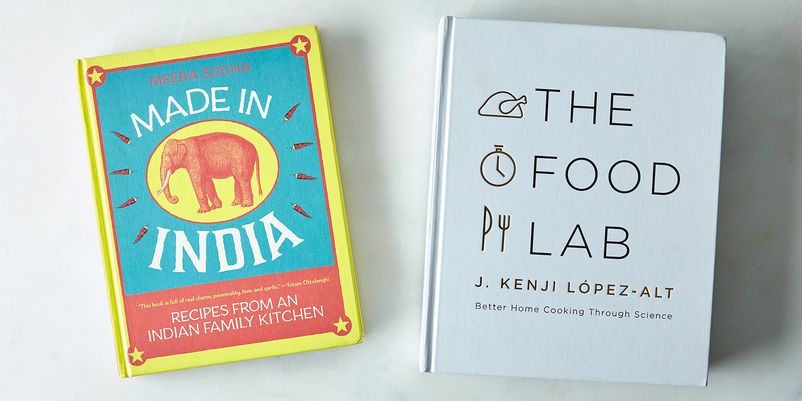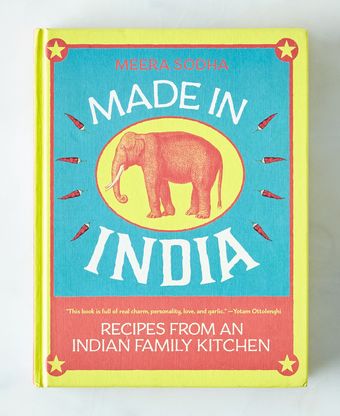The books arrived—one, a doomed little upstart and the other, a swaggering favorite—and, being in mind of brackets, I immediately thought: Gonzaga vs. UConn. Remember Phoenix, 1999, the fourth round of the NCAA tournament? The 10th-seeded Zags, in the midst of one of basketball’s great Cinderella runs, were, improbably, up against the top-seeded Huskies. The game was a thriller, full of errors and foul trouble. With thirty-five seconds left, Gonzaga’s point guard sunk a three-pointer, cutting Connecticut’s lead to one. But the order of things asserted itself, and Connecticut prevailed, 67 to 62. They went on to win the tournament.
Anyway, cookbooks. Meera Sodha’s Made in India is Gonzaga, so palpably underdoggish that it seemed half-sadistic of the nominating committee to have put it in the path of the juggernaut that is J. Kenji López-Alt’s The Food Lab. Sodha is a British cook, born in Lincolnshire to a Gujarati family who fled Uganda in the wake of Idi Amin’s 1972 expulsion of Indian “bloodsuckers.” (Sodha tells the story in the book’s heartfelt introduction, which is illustrated with family snapshots: the entire clan posing on a village green, Sodha in a school blazer with green yarn in her hair.) Sodha explains that, in Uganda, her mother, Nita, never cooked. She had someone to do it for her. In England, she was in the kitchen “day in, day out, to feed her growing family, arranging whatever she could afford into various pots and pans to magical effect, conjuring up tastes and smells of the past and linking us, in an instant, to our ancestral home.” There’s a full-page shot of Sodha and Nita, to whom the book is dedicated, rolling chapatis. She’s as kindly a parent-character as one could conjure—a sort of Dave’s Mom in a sari.
The book’s structure is straightforward, starting with starters and ending with desserts, and then, blessedly, a chapter called “Housekeeping,” which tells you how to make basic items (paneer, yogurt, ghee) and what to do with leftovers (a stray slosh of coconut milk sweetens the daily dal). There’s a humility to this book that’s so appealing. How many cooks have the quiet confidence to write, as Sodha does, positing uses for extra chapatis: “Turn them into chips (see page 272), chapati wraps (see page 64), or feed them to the birds”?
This is all to say that I was smitten before the first mustard seeds hit the pan. Sodha’s premise is that Indian home cooking is fresh, approachable, and quick—“there are no wild-goose recipes in this book,” she writes—so I decided to begin with her recipe for a masala omelette, which she remembers eating on Sunday mornings, “alongside a pile of hot buttered toast, a fresh pot of chai, and Lata Mangeshkar’s timeless, syrupy voice on the stereo.” I had all of the ingredients on hand: eggs, scallions, cilantro, turmeric, chili powder, a green chili. I broke and whisked the eggs; chopped the green things; added them, along with the herbs, to the egg mixture. Then I heated some canola oil in a skillet and, per Sodha’s instructions, poured in a quarter of the omelette mixture, swirling it around and letting it set. “The eggs should be cooked through but a bit soft on top,” Sodha writes. “Flip it over for 30 seconds or so, before shuffling it out onto a plate.” Then she’s back to reminiscing over Bollywood songs. But wait a minute: The other three-quarters of the omelette mixture never resurfaces. Maybe that’s where the toast comes in?
I was disappointed. Having embraced Sodha’s premise of trusty-amateurism, I’d gotten a three-paragraph recipe that fell off a cliff. But I wanted to give her another chance, so, in keeping with my cupboard-friendly approach—the geese can be particularly wild when it comes to Indian ingredients in Paris, where I live—I opted next for the Roasted Tamarind Chicken with Honey and Red Chili. (Honey isn't typically featured in Indian cooking, Sodha explains, but her “uncle” Raymond, a neighbor in Lincolnshire, was a beekeeper.) Again, the recipe-writing left something to be desired. The ingredients section called for “14 ounces bone-in chicken thighs,” which seemed like a complicated way of saying “two chicken thighs,” particularly in a book that elsewhere resists the vogue for giving precise weights for things like herbs and garlic. The preparation was significantly easier than pie: You throw a few things in a bowl to make a paste, rub it on the chicken, and your meal emerges, twenty minutes later, burnished and gooey.
Sometimes you open a cookbook and everything looks great in isolation, but you puzzle over how you might incorporate the various mouthwatering elements into a coherent meal. (This happens to me with Ottolenghi.) Sodha is kind enough to offer a “Menu Ideas” section at the back of the book. This is perhaps unfashionable, but welcome. Ditto the pages on “Wine and Indian Food,” “How to Eat With Your Hands,” and, particularly, the “Help” section. Worried about turmeric stains? Use bright-yellow place mats. The appendix of Indian ingredients continues in this warmly practical and explanatory spirit. Have you ever seen a bitter gourd? I would wear one as an earring.
López-Alt’s The Food Lab enters this tournament with a loud cheering section. López-Alt is the managing culinary director of Serious Eats, where he writes a much-loved column called "The Food Lab," dedicated to “unraveling the mysteries of home cooking through science.” The book is nine-hundred-and-fifty-eight pages long. Its front and back pages feature the sort of charts (volume equivalencies, weight conversions, temperature conversions) that once would have been wildly useful to have on hand, but are dead weight in the age of iPad cooking. For some reason, the same ones are reprinted twice. López-Alt calls his introduction “A Nerd in the Kitchen.” I am slightly suspicious of people who call themselves “nerds,” because the implicit suggestion is that they’re so outwardly fabulous that you’d never have guessed that they’re also quite brilliant. López-Alt’s enthusiasm for his subject is winning, but, by the end of the introduction, less than convincing. “Sure, I earn my keep in a number of ways and testing and writing recipes is only a small part of it,” he writes. “I push commas, I stick words together; I blab about pizza this or hamburger that online, I fake my way through the occasional annoying business meeting or schmooze-fest foodie event; heck, it turns out that I even write a book now and then. But in the end, I’m a cook, and that’s all I ever really wanted to be.”
The Food Lab is a very voicey book. As its narrator, López-Alt, comes off as a strange combination of iconoclast and job-interview candidate, writing that he has “discovered that in many cases—even in the best restaurants in the world—the methods that traditional cooking knowledge teaches us are not only outdated but occasionally flat-out wrong” and, of joining Cook’s Illustrated after eight years of restaurant work, “It was only after this shift that my curiosity finally began to be sated.” He spent much of college, he recalls, debating “such scientific puzzles as precisely how many whiskey-and-Cokes it takes before the next morning’s hangover will prevent you from attending an 11 A.M. lecture.” He is an unapologetic lover of puns (“penne-pincher”), hokey asides (“Not so fast”), and his wife (“Personally, I like the way charred ribs look, enough so that I had my wife’s engagement ring delivered to her on a bone of wild boar chop. Isn’t that romantic?).” He has never met a scientific phenomenon he can’t shoehorn into a glib pop-cultural metaphor (“Think of inosinates at the Robin to glutamate’s Batman”). As accessible as he is trying to be, his attempts to translate nerdspeak into everyday language can feel like pandering. Read him on hamburgers—“We start big fat burgers off on the cooler side of the grill and finish ‘em with a sear in order to get a nice, perfectly even medium-rare”—and you start hearing Sarah Palin. He left desserts out of the book entirely because they just don’t interest him in the way that savory food does. He writes, “Remember that whole thing about not doing anything that I don’t love doing?”
Enough with the close reading—maybe López-Alt’s writing style just isn’t my thing, as desserts aren’t his, and, in red-penning my way through the book, acting out the old clash between the humanities and the sciences, I, too, am falling back into in some sort of collegiate rut. In López-Alt’s world, it’s the results that matter. “It’s an indication that as a population, we’re finally beginning to see cooking for what it truly is: a scientific engineering problem in which the inputs are raw ingredients and technique and the outputs are deliciously edible results.” (His utilitarian outlook extends to the book’s photographs, which recall the aesthetics of a Time-Life primer on bricklaying.) The first recipe I tried was for his Perfect Poached Eggs, and they were indeed impeccable. The key to the method—he credits Heston Blumenthal—is to run the egg, before cooking, through a fine mesh strainer, ridding it of straggly bits of white. I will probably never make another poached egg without doing this. Coming from a guy who’s a stickler for precision, though, whose mission it is to provide an answer to every “why?,” the recipe was a bit mysterious. Why three quarts of water for an unspecified number of eggs? Why two tablespoons of salt? Any one of the benighted cooks that López so confidently dismisses—“Home cooks follow the notes and recipes of their mothers and grandmothers or cookbooks—perhaps tweaking them here and there to suit modern tastes, but never challenging the fundamentals”—could have told him that’s a waste.
López-Alt’s lack of generosity toward the traditions of the kitchen, the folk-wisdom that generations of home cooks—the overwhelming majority of them women—have toiled to attain, made me a little uncomfortable. I decided to attempt his All-American Meatloaf, a hulking eight-pager of a recipe. López-Alt, let it be said, has done his research. He begins, delightfully, by invoking a 1958 cookbook that included seventy variations on meatloaf, including Chili Hot Top Meatloaf (glazed with Heinz Chili Sauce) and Sunshine Meatloaf (ketchup and canned peaches). He has done some tests and come to some conclusions. The meat should be a beef and pork mix; veal has no place in it, powdered gelatin will help the loaf to retain moisture; eggs, buttermilk, and chopped mushrooms also enhance its structure and flavor. “Bread crumbs may, at first glance, seem like an unnecessary extender—something added just to stretch your meat a little further—but they are perhaps the most important ingredient of all when it comes to improving the texture of a meatloaf,” he writes. “Aside from absorbing and retaining some moisture as the meatloaf cooks, they physically impede the meat proteins from rubbing up too closely to one another, minimizing the amount of cross-linking and thus dramatically increasing tenderness.”
It took me two hours and ten minutes to get to step six of the recipe, which is when the meat goes into the loaf pan. (Then you have to cover the loaf pan in heavy-duty aluminum foil, making sure that no air bubbles are lurking underneath, and flip it over onto a rimmed baking sheet, baking for thirty minutes and then, before another forty minutes of baking, using a thin metal spatula to jimmy off the inverted pan. I forget why.) The meatloaf was good. Not great. A little crumblier than promised. I felt like I could taste the presence of what López-Alt calls “my trusty umami bombs: anchovies, Marmite, and soy sauce.” They were a little off-putting, in theory more than in actual flavor. They just didn’t seem like they needed to be there, like they had much to do with the dish, any more than did the fish sauce that López-Alt adds to his take on spaghetti bolognese. (And, now, in the vein of sports metaphors, I fear I’m the grumpy, low-scoring Ukranian judge.)
What’s so wrong with the cooking of mothers and grandmothers anyway? Who can’t tolerate a floater or two in their poached-egg pot? López-Alt’s approach, flawless as its byproducts can be—do score your pork chops before pan-searing them, as he instructs—is, I realized, fundamentally at odds with the way I want to cook. To the López-Alt disciple, it might sound pre-Galilean, but maybe there is no perfect poached egg. Gonzaga wins!



136 Comments
And he overpromises/under-delivers - science hasn't always made his recipes the best. I agree that his meatloaf and spaghetti bolognese recipes are blah and not everything needs umami bombs.
Reading about cooking the way he writes about it puts me off, and well that may not be true for every person who encounters Kenji, it was true for this reviewer.
"López-Alt’s lack of generosity toward the traditions of the kitchen, the folk-wisdom that generations of home cooks—the overwhelming majority of them women—have toiled to attain, made me a little uncomfortable."
No unreasonable bias here.
I do have an answer to her hypothetical question, though: "what's so wrong with mothers and grandmothers?" Nothing, of course, except that they didn't teach me how to cook. The internet did.
As a young man, I grew up in a house where women cooked, unless my father was barbecuing. My mother made meals, and the rest of us ate them. I never learned to cook until I was a college student, and by then my mother wasn't around to teach me. I learned how to cook by googling it, and by teaching myself. Lopez-Alt's writings have, for me, been an indispensable part of that process.
For those who, like me, learned to cook through the written word and youtube videos, rather than through participation with experienced cooks, there is comfort in exactitude. There's a kind of certainty in gram weights as measures, rather than descriptors like "a pinch". There's reassurance in the notion that there is a "right" way to poach an egg, and that if you follow it you'll be okay.
For those who don't come from a rich culinary tradition, who've never sat around a stockpot all Sunday with grandma or learned a family recipe for anything, The Food Lab offers a doorway to a culinary tradition anyone can call their own.
I love the Food Lab for both its solid technique and its voice. I don't always care for the modifications... some of them turn a simple task into a large scale construction project without always making the end result better, in my opinion. Some of FoodLab's recipes (fried chicken, pie crust dough, biscuits, goulash, bolognese sauce) are not an improvement over classic preparation despite adding time and ingredients that can be difficult to obtain. The greatest thing about the FoodLab book, though, is that Kenji trains his readers to think critically about how their technique and ingredient choices impact the end result of any dish.
I have not read "Made in India" and doubt I will... I would enjoy the story telling aspect of that book but I dislike international food recipes that are badly written, poorly seasoned, lacking in descriptive technique, and relatively untested. Several readers have commented on that, so I'll pass.
I can't take this author's comments about cookbooks seriously after reading this review. The criticisms leveled at Kenji's book are pretty trivial... like looking for the window washer's fingerprints on a 20 story building. I also think the review of his book reads like a petty high schooler mad at the girl selected to be the head cheerleader.... childish and petulant, with complaints lacking in substance and, so, are instead personal in nature.
And as for the bolognese, it's pretty much Barbara Lynch's very classic bolognese sauce (one of her most renowned dishes with good reason, as it's a perfectly silky, rich, and savory) with a few modifications.
I also grew up with both parents working, there was no real cooking going on or passing down of traditions. I started cooking in my late 20's and learned everything from trial and error, so to have resources like Food Lab and Serious Eats is amazing.
PS. Kenji's a big deal, I'm sure this Piglet loss isn't weighing on him like it's weighing on a lot of these commenters.
But I would really like to see reviews based on something more concret than "What's wrong with grandmas recipes?"
Sounds like the judge didn't like reading The Food Lab, but didn't like cooking out of Made in India. Seems like a cookbook tournament should also judge the cooking, not just the prose. I didn't enjoy the prose here, too bad too, as I usually enjoy this little competition.